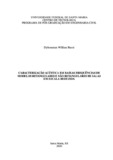| dc.creator | Russi, Dyhonatan Willian | |
| dc.date.accessioned | 2021-09-15T03:52:12Z | |
| dc.date.available | 2021-09-15T03:52:12Z | |
| dc.date.issued | 2020-08-31 | |
| dc.identifier.uri | http://repositorio.ufsm.br/handle/1/22219 | |
| dc.description.abstract | Choosing the correct analysis methodology to study and design acoustic behavior at low fre- quencies, considering small non-rectangular rooms and critical listening rooms, can influence the auditory sensations that the user of the room will have when making use of the space. This research compares two methodologies that analyze low frequencies in small scale models, of possible rectangular and non-rectangular shapes, of acoustic rooms. Comparisons are made between the parameters T20, T30, EDT, C80, D50 and Ts, obtained in computational models that make use of the finite element method (FEM) and analytical calculation models that make use of the equations that describe the acoustic behavior of rectangular rooms with rigid walls. This research also evaluated, through Pearson’s correlation coefficient r, the similarity between the decay curves, in the form of the inverted cumulative integrals of the impulse responses (ICI), evaluated the similarity between the frequency response functions (FRF) and evaluated the si- milarity between the impulse responses (IR), obtained with these evaluation methodologies. The results indicate that the less rectangular the shape of the room is, smaller will be the simi- larity between the impulse responses obtained in the methodologies. This fact can influence, for example, the acoustic perception in a non-rectangular room designed using analytical mo- dels for rectangular rooms. The methodologies used in this research were validated with the measurement of a physical model built on a small scale, after identifying the convergence of results between the data obtained in the measurements, in the virtual models in FEM and in the analytical ones. All geometric shapes, of the possible acoustic rooms, were elaborated on a reduced scale, with a reduction ratio of (1: 8). The data obtained in these measurements were used as input data for other analyzes made by this research. | eng |
| dc.language | por | por |
| dc.publisher | Universidade Federal de Santa Maria | por |
| dc.rights | Attribution-NonCommercial-NoDerivatives 4.0 International | * |
| dc.rights.uri | http://creativecommons.org/licenses/by-nc-nd/4.0/ | * |
| dc.subject | Baixas frequências | por |
| dc.subject | Acústica modal | por |
| dc.subject | Salas não retangulares | por |
| dc.subject | Modelos escala reduzida | por |
| dc.subject | Coeficiente de correlação | por |
| dc.subject | Low frequencies | eng |
| dc.subject | Modal acoustics | eng |
| dc.subject | Non-rectangular rooms | eng |
| dc.subject | Reduced scale models | eng |
| dc.subject | Correlation | eng |
| dc.title | Caracterização acústica em baixas frequências de modelos retangulares e não retangulares de salas em escala reduzida | por |
| dc.title.alternative | Low-frequency acoustic characterization of rectangular and non-rectangular models of small-scale rooms | eng |
| dc.type | Dissertação | por |
| dc.description.resumo | A escolha da metodologia de análise para estudar, analisar e projetar o comportamento acústico em baixas frequências, de salas de pequeno porte, não retangulares e salas de escuta crítica, pode influenciar nas sensações auditivas que o usuário da sala terá, ao fazer uso do espaço. A presente pesquisa compara, duas metodologias de analisar as baixas frequências em modelos de escala reduzida, de possíveis formatos, retangulares e não retangulares, de salas acústicas. As comparações são feitas entre os parâmetros T20, T30, EDT, C80, D50 e Ts, obtidos em mo- delos computacionais que fazem uso dos métodos de elementos finitos (FEM) e em modelos analíticos de cálculo que fazem uso das equações que descrevem o comportamento acústico de salas retangulares com paredes rígidas. Essa pesquisa avaliou ainda, por meio do coeficiente de correlação de Pearson r, a similaridade existente entre as as curvas de decaimento, sobre a forma das integrais cumulativas invertidas das respostas ao impulso (ICI), avaliou a similari- dade existente entre as funções de resposta em frequência (FRF) e avaliou a similaridade entre as respostas ao impulso (RI), obtidas nessas metodologias de avaliação. Os resultados mostram que, quanto menos retangular é o formato da sala, menor é a similaridade entre as respostas ao impulso obtidas nas metodologias. Esse fato pode influenciar, por exemplo, a percepção acústica em uma sala não retangular projetada com uso de modelos analíticos para salas retan- gulares. As metodologias usadas nesta pesquisa foram validadas com a medição de um modelo físico construído em escala reduzida, após identificada a convergência de resultados entre os dados obtidos nas medições, os dados obtidos nos modelos virtuais em FEM e os dados obtidos nos analíticos. Todas formas geométricas, das possíveis salas acústicas, foram elaboradas em escala reduzida, com proporção de redução de (1:8). Os dados obtidos nessas medições foram usados como dados de entrada para todas as outras análise feitas por essa pesquisa. | por |
| dc.contributor.advisor1 | Carneiro, Eric Brandão | |
| dc.contributor.advisor1Lattes | http://lattes.cnpq.br/2876372207029481 | por |
| dc.contributor.referee1 | Gomes, Marcio Henrique de Avelar | |
| dc.contributor.referee1Lattes | http://lattes.cnpq.br/6090334823327910 | por |
| dc.contributor.referee2 | Melo, Viviane Suzey Gomes de | |
| dc.contributor.referee2Lattes | http://lattes.cnpq.br/5640661336499240 | por |
| dc.creator.Lattes | http://lattes.cnpq.br/8464826818398791 | por |
| dc.publisher.country | Brasil | por |
| dc.publisher.department | Engenharia Civil | por |
| dc.publisher.initials | UFSM | por |
| dc.publisher.program | Programa de Pós-Graduação em Engenharia Civil | por |
| dc.subject.cnpq | CNPQ::ENGENHARIAS::ENGENHARIA CIVIL | por |
| dc.publisher.unidade | Centro de Tecnologia | por |



